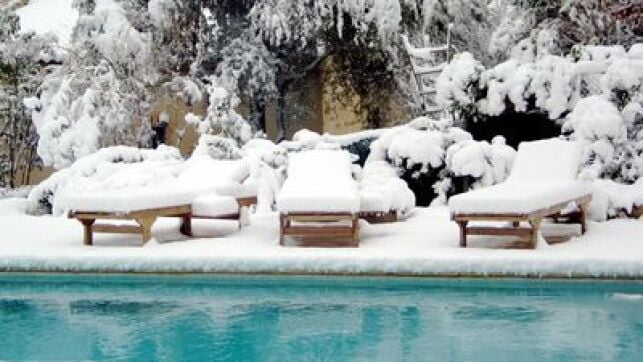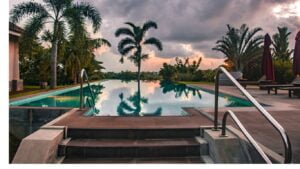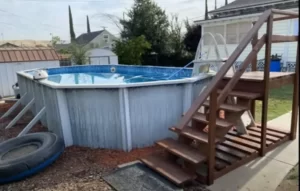When the cold season arrives, the winterize of a pool allows for the preservation of the water and the facilities until the return of the beautiful days. Depending on the region where you live, you will have to choose between two different pool winterization techniques: passive winterization or active winterization, which each require special maintenance processes.

Contents
Winterize of a pool to preserve water and equipment
When winter approaches and the bathing season is definitely over, the pools are no longer used. But there is no question of emptying them and leaving them without water all winter!
Because, apart from a few exceptional cases, you should never empty a pool entirely (especially for a long time). An empty pool is a swimming pool that is subjected to the pressure of the terrain that surrounds it. With, in the key, risks that the basin moves or digs up, that the walls crack, that the coating is damaged…
In fact, rather than emptying the pool, it is necessary to winterize the pool: an operation that allows not only to protect the structure and cladding but also conserve the pool water during the winter… to reuse it when spring comes again.
When should I winterize a pool? The importance of water temperature
Winterizing a swimming pool is an exact science, which leaves very little room for the unexpected. Thus, as soon as the water temperature drops below 12°C and remains constant, it is time to winterize the pool.
The threshold of 12 °C has obviously not been chosen at random; it is a threshold from which algae and other microorganisms can no longer grow.
Likewise, it is better not to winterize a pool too early to ensure that the water retains its quality. But be careful not to wait too long either; if winter arrives too quickly, frost may cause great damage…
That is why it is relevant to refer to the threshold of 12°C to put the pool in winterize!
How to winterize a pool: the different winterizing techniques
Knowing why and when to winterize a pool is a first step. Make sure she gets through the winter. You also need to know how to winterize a pool properly!
In this respect, there are two different pool winterization techniques: active winterization and passive winterization.
Active winterizing is a method of winterizing that involves idling the pool, running the filtration for a few hours a day, and maintaining the maintenance of the pool.
It opposes passive winterization, a technique that does not require any maintenance since it involves completely stopping the pool during the winter!
How to choose your pool winterize technique?
In reality, the choice between active winterizing techniques depends primarily on the weather.
Indeed, the enemy number 1 of swimming pools in winter is frost: when water starts to freeze in pipes or equipment, it swells, becomes denser… at the risk of bursting the pipes !
That is why pool owners located in cold regions and where winters are « at risk » must opt for a passive winterize of their pool, and put it completely to sleep for a few months.
The active winterize technique is reserved for areas in which winters are quite mild, or swimming pools equipped with a heating system that are not afraid of frost !
Passive winterize of a pool: when the pool is stopped
During passive winterize, the pool will staying asleep throughout the winter, which will result in stopping filtration, cleaning and maintenance of water and basin.. nothing easier in terms of maintenance !
However, this winterize technique requires a protocol that is quite demanding to be implemented :
- A complete and thorough cleaning of the basin.
- A shock treatment of the water so that it is perfectly healthy.
- La lowering of water level.
- Drainage and over winterize of the pool filtration system so that water does not freeze and degrade equipment.
- Adding an winterize product anti-algae and anti-limestone to protect water and basin
- The installation of winterize accessories (gizzmos, floats, caps, winterize balloon.) to prevent frost from degrading equipment.
- The establishment of a winterize blanket.
Active winterize of the pool: when the pool is idling
The so-called active winterize technique involves maintaining the water filtration during the winter season, but at a fairly low rate, on the order of 2 hours / day on average. Active winterize is easier to implement than passive winterize, since it simply requires :
- Pour a winterize product into the pool at the start of winter ( and if necessary, renew the operation).
- Check the pH and balance of the water regularly.
- Create movements in the water to avoid freezing ( by opening the skimmers for example).
- Configure the out-of-gel box so that it automatically starts the pump when the basin water reaches a certain temperature (always in order to avoid frost).
With active winterize, it is not mandatory to cover the pool with a winterize tarp; : ideal to continue to enjoy it, at least visually, during the long winter evenings!
Maintenance of a swimming pool in winter: do not forget the winterize tarp
It is a fact: maintaining a swimming pool in the winter requires much less work than in the summer, when it is frequented! However, it should be borne in mind that regardless of the pool winterize technique chosen, there will be maintenance to be performed.
Indeed, in case of active winterize, it is necessary to ensure a regular maintenance of the pool : check the pH, the disinfectant rate, empty the baskets of skimmers, clean the basin, not to mention create water movements to avoid frost.
And even if the passive winterize is less restrictive in terms of maintenance, it is still advisable to monitor from time to time the color of the water, but especially remove plant debris, snow and/or rain piled on the winterize tarp to prevent it from sagging and damaging under their weight.

My name is James A. Bright, and I have worked in the pool and plumbing industries for over 15 years. I started poolprosoutions.com to share my experience with you guys. Here, I provide helpful guides and tips related to pool care, hot tub care, underground water leaks, and pipe leaks.



